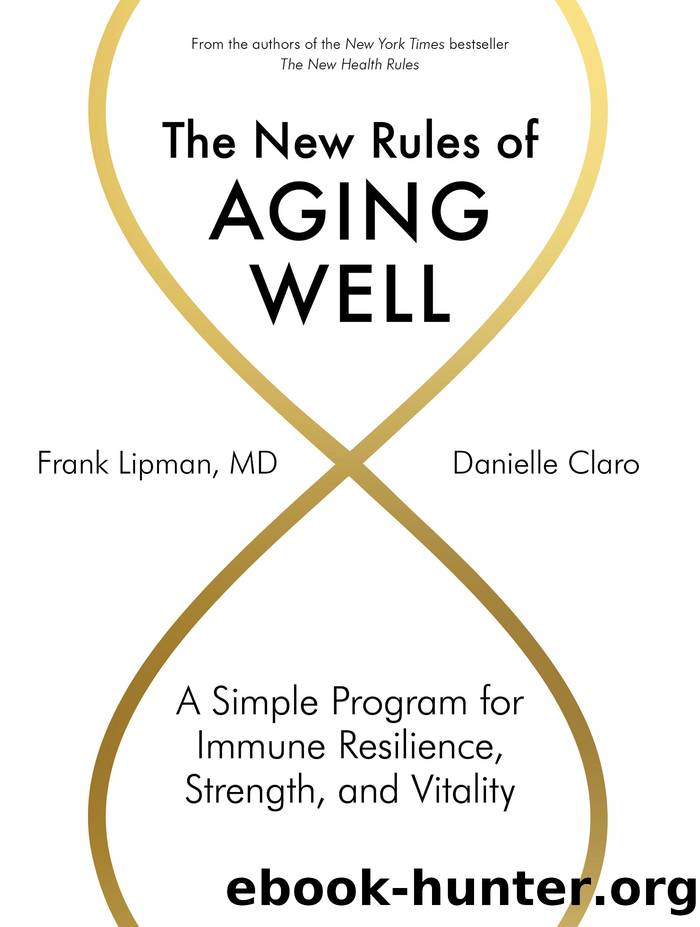The New Rules of Aging Well: A Simple Program for Immune Resilience, Strength, and Vitality by Frank Lipman & Danielle Claro

Author:Frank Lipman & Danielle Claro [Lipman, Frank & Claro, Danielle]
Language: eng
Format: epub
Amazon: 1579659594
Publisher: Artisan
Published: 2020-06-16T20:08:52+00:00
Bone broth heals holes in the gut
Thereâs no real difference between bone broth and stockâthe term âbone brothâ was a branding thing. The benefits of the stuff, no matter what you call it, are real, and consumed regularly, bone broth can help protect the gut lining and even help heal damage to the gut wall. You can buy a good prepared brand like Kettle & Fire or Vital Choice, but homemade is going to be even more nutritious and more healing (and also less expensive).
If you already know how to make stock, youâre probably set. If not, hereâs some guidance from New York City chef Marco Canora, founder of the renowned bone broth company Brodo. You donât need to follow a precise recipe. What matters is the quality of your ingredientsâorganic, hormone-free, grass-fed and grass-finishedâand a nice long cook time.
Throw 2 to 4 pounds of meaty bones in a big pot. You can use bones from poultry, beef, lamb, or fishâeven just the meaty carcass of a whole roast chicken. Cover the bones with water, and add 3 or 4 tablespoons of good apple cider vinegar. Let this sit for 30 minutes to 1 hour, without turning on the flame. Bring the pot to a boil, then turn it down to a gentle simmer. Cover and cook on low heat for at least 6 hoursâgo even longer if you like. This extracts the most gelatin and nutrients from the bones. Toward the end, you can throw in some Himalayan salt, garlic, carrots, and herbs if you like. Once the broth is done, remove the pot from the heat and let it cool a bit. Pick out and toss the big bones, then strain the broth through a fine-mesh sieve or a regular strainer lined with cheesecloth and let cool completely. When fully cooled, the broth should wiggle like jelly thanks to the high gelatin content (gelatin is the cooked form of collagen)âthatâs what nourishing broth looks like. If your broth doesnât turn gelatinous, itâs still very good for you; just add more gristle to the mix next time (ask your butcher for feet, knucklebones, or necks, or include the skin from a roast chicken; if youâre making fish broth, use the head). You can store your broth in glass mason jars in the fridge. If you want to freeze it, leave a couple of inches of space at the top of containers to allow for expansion, or freeze without lids and cap containers later.
When you want some broth, open a container, scoop off and toss the solid layer of fat on top, then warm the broth in a saucepan. (Donât microwave bone broth; it changes the composition of the nutrients.) Crush fresh herbs like thyme or rosemary, if youâve got them on hand, drop them into the bottom of a mug, then pour in your broth. The heat will bring out the flavor of the herbs. If you have a small milk frother, you can stick that in the cup and whip the broth to make it creamy.
Download
This site does not store any files on its server. We only index and link to content provided by other sites. Please contact the content providers to delete copyright contents if any and email us, we'll remove relevant links or contents immediately.
The Longevity Diet by Valter Longo(4838)
The Body: A Guide for Occupants by Bill Bryson(4542)
Ikigai by Héctor García & Francesc Miralles(3833)
Limitless by Jim Kwik(2943)
The Checklist Manifesto by Atul Gawande(2626)
The Body by Bill Bryson(2499)
Memory Rescue by Daniel G. Amen(2230)
What Color Is Your Parachute? 2015 by Richard N. Bolles(2190)
Becoming Myself by Irvin D. Yalom(2138)
Breath by James Nestor;(2132)
Fat for Fuel by Joseph Mercola(1918)
Memory Rescue: Supercharge Your Brain, Reverse Memory Loss, and Remember What Matters Most by Amen Dr. Daniel G(1824)
Awakening Your Ikigai by Ken Mogi(1706)
Weight Training by Thomas Baechle(1655)
50 After 50 by Maria Leonard Olsen(1604)
Starting Over (Sugar Creek Romance ) by Jordan Silver(1577)
1610396766 (N) by Jo Ann Jenkins(1542)
The Telomerase Revolution by Michael Fossel(1518)
Dirt by Bill Buford(1493)
